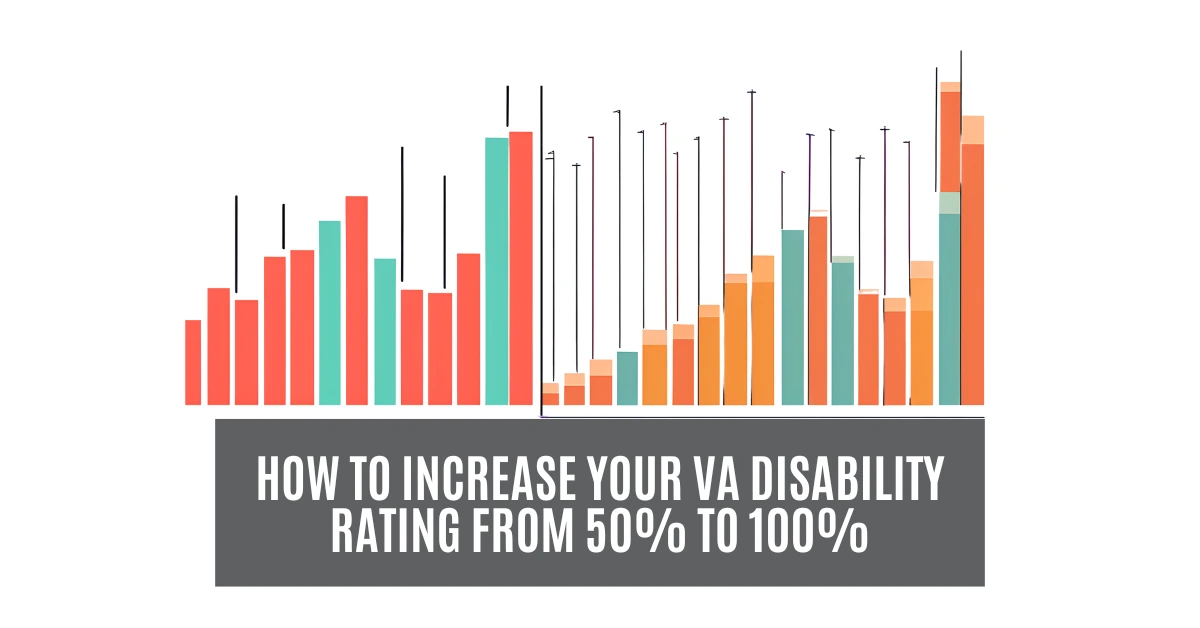Having a 50% VA disability rating provides important benefits, but in some cases, it may not fully reflect the impact of service-connected conditions. If symptoms have worsened, increasing your rating could provide higher compensation and additional healthcare support.
Moving from 50% to 100% is possible through a rating increase request, Total Disability based on Individual Unemployability (TDIU), or additional secondary conditions. Understanding how the VA evaluates claims is key to making a successful case.
This guide will walk you through the VA disability rating system, the re-evaluation process, and steps you can take to maximize your benefits.
Understanding VA Disability Ratings
VA disability ratings determine monthly compensation and eligibility for additional benefits. Ratings are assigned in 10% increments, ranging from 0% to 100%, based on the severity of service-connected conditions.
The VA Schedule for Rating Disabilities (VASRD) outlines how conditions are evaluated. Each disability has a diagnostic code with criteria for different rating levels. A higher rating requires medical evidence showing more severe symptoms or functional limitations.
Some veterans qualify for a 100% rating under Total Disability based on TDIU if they can’t work due to service-connected conditions. This allows full compensation without meeting the strict criteria for a schedular 100% rating.
If your current rating doesn’t reflect your disability’s true impact, you may be eligible for an increase. The next section explains how to request re-evaluation and submit the necessary evidence.
Re-Evaluation for Increased Rating
If your condition has worsened since receiving a 50% rating, you can request a re-evaluation to increase your benefits.
This process involves submitting medical evidence, attending a Compensation & Pension (C&P) exam, and demonstrating how your disability has progressed.
To start, file a claim for an increased rating through VA.gov or submit VA Form 21-526EZ. Supporting documentation should include recent medical records, private doctor opinions, and statements from family or coworkers.
A C&P exam may be required. The examiner will assess how your symptoms impact daily life and employment. Be honest and detailed about limitations, even if they fluctuate. If the exam is unfavorable, you can challenge the findings with additional evidence.
When proving a need for a higher rating, consider the following:
- Medical Worsening – Show recent treatment records reflecting increased severity.
- Functional Impact – Explain how daily tasks and work are affected.
- Secondary Conditions – Identify any new disabilities related to your service-connected condition.
If your request is denied, you can appeal through a Higher-Level Review or Board Appeal. Persistence and strong medical evidence are key to securing a higher rating.
Applying for TDIU
If your service-connected conditions prevent you from maintaining substantially gainful employment, you may qualify for Total Disability based on Individual Unemployability (TDIU). This allows you to receive 100% compensation even if your combined rating is lower.
To qualify, you must meet one of these criteria:
- One service-connected disability rated at least 60%.
- Two or more service-connected disabilities, with at least one rated at 40% or higher and a combined rating of 70% or more.
If you meet these, submit VA Form 21-8940 (Application for Increased Compensation Based on Unemployability) along with evidence showing your inability to work. This can include:
- Medical records proving worsening conditions.
- Statements from doctors linking disabilities to employment limitations.
- Work history reports detailing past jobs and employment struggles.
The VA may request a C&P exam to evaluate your ability to work. Be specific about how your conditions affect daily tasks, concentration, and physical demands.
Even if you don’t meet the rating criteria, you can apply for extraschedular TDIU, where the VA evaluates how your unique case impacts employability. If denied, consider filing a Higher-Level Review or Board Appeal.
Secondary Service Connection and Combined Ratings
A secondary service connection applies when a service-connected condition causes or worsens another disability. This can increase your combined rating and bring you closer to 100% compensation.
For example, if you have a service-connected knee injury that leads to arthritis, the arthritis may be rated separately as a secondary condition. Other common secondary claims include:
- Depression or anxiety due to chronic pain.
- Sleep apnea caused by PTSD or weight gain from medication.
- Neuropathy linked to diabetes from Agent Orange exposure.
To establish a secondary connection, you need:
- A diagnosis of the secondary condition.
- A medical nexus letter from a doctor linking it to your service-connected disability.
When multiple disabilities are rated, the VA doesn’t add them linearly but instead uses the Combined Ratings Table. It means that two 50% ratings won’t equal 100%, so pursuing additional secondary conditions may be necessary to reach a higher combined rating.
Strengthening Your Claim with Medical Evidence
Strong medical evidence is the key to proving your need for a higher rating. Without it, the VA may deny or underrate your claim.
Your evidence should clearly document symptoms, functional limitations, and the condition’s progression. Useful forms of evidence include:
- Recent VA or private medical records with a history of worsening symptoms.
- Nexus letters from specialists confirming service connection or disability progression.
- Buddy statements from family, coworkers, or fellow veterans describing how your condition affects daily life.
If a VA C&P exam doesn’t fully capture your disability’s severity, consider getting an Independent Medical Opinion (IMO) from a private doctor. This can provide detailed evidence to challenge a low rating or denial.
Conclusion
Increasing your VA disability rating from 50% to 100% takes a combination of strong medical evidence, secondary conditions, and potentially applying for TDIU.
If your condition has worsened or impacts your ability to work, don’t hesitate to request a rating increase or explore TDIU options. The key is thorough documentation and persistence.
